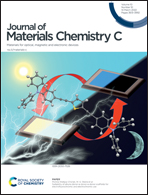Photocatalytic activity enhancement of Cu2O cubes functionalized with 2-ethynyl-6-methoxynaphthalene through band structure modulation†
Abstract
Since the exciting discovery that binding of 4-ethynylaniline on inert Cu2O cubes makes the functionalized cubes highly photocatalytically active toward methyl orange (MO) degradation, binding of 2-ethynyl-6-methoxynaphthalene (2E-6MN) molecules was found to produce a similar effect to activate Cu2O cubes. A moderate activity enhancement was observed for the functionalized Cu2O rhombic dodecahedra, while the activity of octahedra only improves slightly. Thus, the degree of photocatalytic activity enhancement is highly facet-dependent. Electron, hole, and radical scavenger tests confirm the photocatalysis results. Electrochemical impedance measurements also show a reduced charge transfer resistance after 2E-6MN modification for cubes and rhombic dodecahedra. Moreover, density functional theory (DFT) calculations have revealed the emergence of narrow bands within the band gaps of Cu2O{100} and {110} surfaces, but not on the {111} surface. Charge density distribution analysis is also insightful to understand the pronounced photocatalytic activity of the modified Cu2O cubes. Surface functionalization with conjugated molecules represents a new strategy to activate or enhance photoinduced charge transfer of semiconductor materials.

- This article is part of the themed collection: 2023 Journal of Materials Chemistry C Lunar New Year collection


 Please wait while we load your content...
Please wait while we load your content...